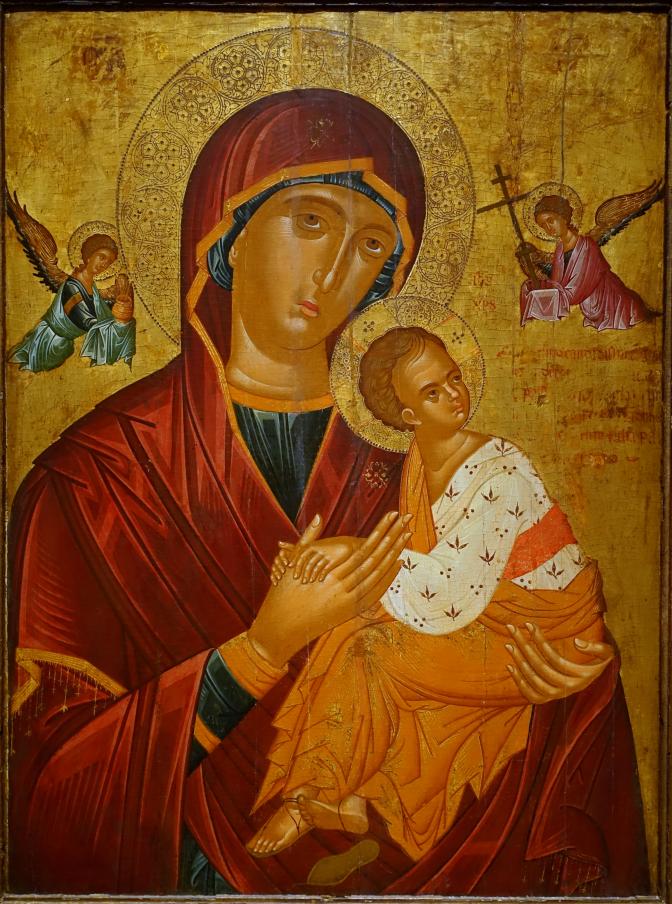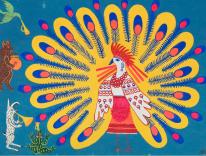The newly completed St. Nicholas Greek Orthodox Church in New York City is more than a simple reconstruction of the original church, which was destroyed by the collapse of the World Trade Center’s south tower on September 11, 2001. The new church, designed by architect Santiago Calatrava, is meant to resemble a mosaic of the Virgin Mary at Hagia Sophia in Istanbul. And when the Mary-shaped church of St. Nicholas is paired with the two depressive marks of the 9/11 memorial, the angelic wings of Calatrava’s nearby World Trade Center Transportation Hub, and the famous Ground Zero cross at the National September 11 Museum, something else comes into view. The site evokes the famous Christian icon known as the Virgin of the Passion, more popularly known as Our Lady of Perpetual Help. In this icon, Mary holds her son while two angels hover above them bearing the instruments of the Passion—the cross, spear, and sponge. There is already a church dedicated to this famous icon in New York, Brooklyn’s imposing Basilica of Our Lady of Perpetual Help. But thanks to St. Nicholas Church, now an even larger, more central monument resembles the icon as well, even if the architect himself may not have realized it.
While art history is packed with images of Mary titled “Our Lady of Victory,” the Virgin of the Passion icon might more fittingly be called “Our Lady of Loss.” She emerged from the losing side of the Crusades (a story related in my book Mother of the Lamb). The first surviving example of the icon in the history of art appears on the island of Cyprus, where the Byzantine artist Theodore Apsevdis painted her in response to the occupation of the island by the Crusaders, who slaughtered the Orthodox population on Easter morning in 1192. The angels flanking Mary in this image swapped their confident scepters for the cross, spear, and sponge.
As the Byzantine Empire slowly crumbled, the Virgin of the Passion emerged as the emblem of a vanishing empire. With Byzantium’s final collapse in 1453, icons of the Virgin of the Passion were in high demand throughout Europe. Artists such as Andreas Ritzos would include inscriptions in both Latin and Greek to reach both Catholic and Orthodox clients. Everyone, it seems, wanted this token of a destroyed Christian empire.

Catholics embraced the image so enthusiastically that it received a new name, Our Lady of Perpetual Help. When the Redemptorists of Rome took a liking to one miracle-working copy of the image, they managed to secure the attention of Pope Pius IX, who commanded them to spread it around the world. Little did Pius IX realize, however, that the icon’s connection to military defeat would soon apply to him. Against his many protestations, Piux IX lost the Papal States. His adopted icon could not have been more fitting, but for reasons he probably did not intend. Once again, the Virgin of the Passion paved the way for forms of Christianity less wedded to the powers of this world.
Sometimes the icon even appears to correct the errors of Christian history. It may be the case, for example, that the Holy Roman Emperor Charlemagne waged war on the Saxons “until they had either been overcome and subjected to the Christian religion or totally exterminated.” And yet, when you travel to that empire’s former capital of Aachen to see Charlemagne’s skull and his glitzy imperial cross still on display in the cathedral treasury, you cannot help but run into a beautiful Virgin of the Passion that was recently placed in the very same museum. There she makes the same point that Charlemagne’s advisor Alcuin did: forced conversions are not in keeping with Christianity, and faith does not require the scaffolding of political and military might.
The icon also has a tragic connection to the Iraq War, which was our national response to the September 11 terrorist attacks. In the wake of failed American efforts to stabilize Baghdad, fifty-nine worshipers, priests, policemen, and bystanders were killed by the Islamic State of Iraq during a Sunday evening Mass in that city on October 31, 2010. Some of the survivors fled to America and replicated their church in El Cajon, California. The church is now known as Our Lady of Perpetual Help Syriac Catholic Church, and its memorial for those killed in Iraq is crowned, fittingly enough, with a Virgin of the Passion icon.
The Crusades differ from America’s invasion of Iraq in important ways. But there are at least two similarities: neither of these missions fully succeeded, and both unintentionally gave rise to this icon of love and mercy, whether in the original Virgin of the Passion icon now found all over the world, or in the memorial to modern martyrs in El Cajon, California, and now at Ground Zero.
The Twin Towers once seemed to cast their long shadow on all of New Jersey, where I grew up. The mindset I absorbed as a child took U.S. military, economic, and cultural preeminence for granted. But the Virgin of the Passion, whose image has lately appeared at the site of the September 11 disaster, has recalibrated my perspective. That shift falls into a pattern recapitulated throughout the history of Christianity. The young St. Benedict traded the privileges of a vanishing Roman aristocracy for the more promising prospects of monasticism; only the latter would last. Orthodox Christians in the Mediterranean correctly prioritized the church above the Byzantine Empire, especially in its waning years, for only one of those entities had a future. Early twentieth-century Catholics rightly relinquished the Papal States for the comparably miniscule Vatican City, whose only power is spiritual. Perhaps it will be the same for American Evangelicals, who have lost much of the political favoritism they once enjoyed.
In each of these cases, Our Lady of Perpetual Help illuminates the way. She is an image for the kind of Christian humanism so well described by Luke Bretherton, one that resists “both cultural triumphalism and cultural relativism.” This Mary represents a faith not of hubris but of humility, a faith in which violence never has the last word. There were already shrines to her all across America—in Washington D.C., Los Angeles, St. Louis, Chicago, and Boston, to name just a few. But perhaps her most poignant shrine is the one Santiago Calatrava has given us in New York, marking a site of devastating loss with an emblem of true Christian lament and hope.
Please email comments to [email protected] and join the conversation on our Facebook page.
Previous Story
Is Christianity a Cult of the Dead?
Next Story
Poem | Baptism

